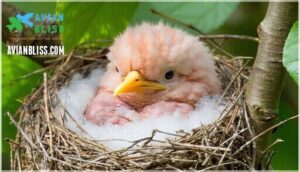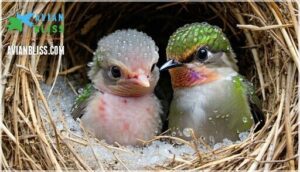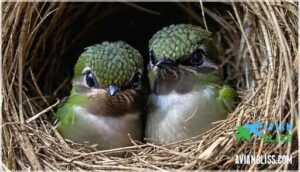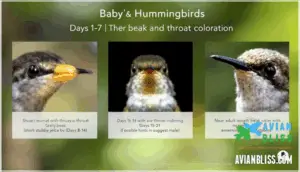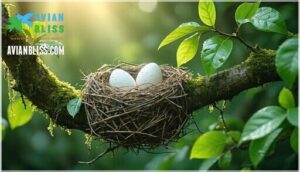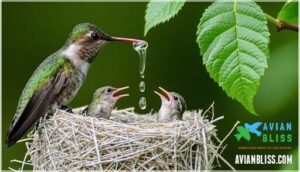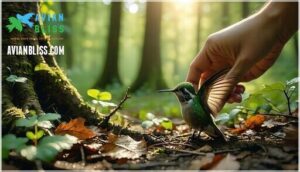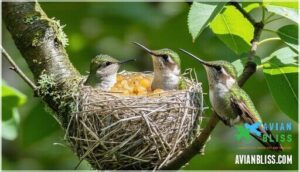This site is supported by our readers. We may earn a commission, at no cost to you, if you purchase through links.
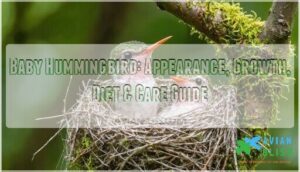
For the first week of life, they’re completely helpless, relying on their mother’s split-second precision to survive. She’ll feed them every 20 minutes from dawn to dusk, cramming enough protein and nectar into their pin-sized bodies to double their weight in just 24 hours.
Within three weeks, these fragile hatchlings transform into iridescent acrobats capable of flying backwards and hovering mid-air—one of nature’s most dramatic metamorphoses.
Table Of Contents
- Key Takeaways
- Baby Hummingbird Appearance and Traits
- Hummingbird Eggs and Nest Construction
- Life Cycle of a Baby Hummingbird
- Diet and Feeding Habits of Chicks
- Growth and Development Stages
- Mother’s Role in Chick Care
- Predators and Threats to Baby Hummingbirds
- What to Do if You Find a Chick
- Fascinating Facts and Conservation Tips
- Frequently Asked Questions (FAQs)
- What does a baby hummingbird look like?
- What do juvenile hummingbirds look like?
- Why don’t we see baby hummingbirds?
- How long does it take for a baby hummingbird to fly?
- When is hummingbird mating season?
- How many broods do hummingbirds have per year?
- How long does hummingbird egg incubation take?
- What are the main causes of hummingbird nest failure?
- How do hummingbird chicks learn to feed themselves?
- How long do hummingbirds live in the wild?
- Conclusion
Key Takeaways
- Baby hummingbirds hatch at under one gram (less than a dime’s weight), completely blind and featherless, then transform into flight-capable fledglings in just three weeks—one of nature’s fastest developmental timelines.
- Mothers feed chicks every 20 minutes from dawn to dusk with regurgitated insects and nectar, enabling hatchlings to double their body weight within 24 hours during peak growth periods.
- Hummingbird populations face severe decline (some species down 67% since 1970, with 21 species endangered) primarily due to habitat loss, pesticides, and urban threats like window strikes.
- You can directly support hummingbird survival by planting native nectar sources, maintaining clean feeders with proper sugar ratios.
Baby Hummingbird Appearance and Traits
When you first spot a baby hummingbird, you mightn’t recognize what you’re looking at. These tiny creatures look nothing like their jewel-toned parents, starting life as fragile little beings barely bigger than a coffee bean.
Here’s what sets newborn hummingbirds apart from the adults you’re used to seeing at your feeder.
Size, Weight, and Initial Appearance
When a hummingbird chick first tumbles out of its egg, it’s about the size of a penny—barely an inch long and weighing roughly 0.62 grams, or about one-third the weight of a dime. These baby hummingbirds arrive completely helpless:
- They’re born blind with sealed eyes
- Their bodies are naked and featherless
- Their beaks are stubby, short, and yellow
Hummingbird chicks can’t regulate body temperature or feed themselves initially, making them entirely dependent on their mother for survival.
Skin Color and Pinfeather Growth
Those bare, pink-to-gray hatchlings don’t stay naked for long—around day 10, their bodies start sprouting tiny pin-like feathers that look more like dark stubble than actual plumage. This feather development marks a significant shift in avian development, as hummingbird chicks gradually gain thermal regulation abilities.
| Growth Stage | Skin Pigmentation | Feather Status |
|---|---|---|
| Days 0-3 | Pink to gray | Completely bare |
| Days 10-14 | Darkening patches | Pin-like stubble emerges |
| Days 18-21 | Hidden under plumage | Full feather coverage |
By week three, baby hummingbirds transform from vulnerable hatchlings into insulated bird development miracles.
Eye Development and Opening Timeline
Right around the time those pinfeathers break through, sealed eyelids finally crack open—usually between days 5 and 8, depending on the species. This vision development point frees hummingbird babies from their hatchling blindness and launches a rapid shift in avian development:
- Eye Closure Duration: Roughly 5-8 days of total darkness
- Light Sensitivity: Eyes adjust gradually to prevent retinal damage
- Vision Development Stages: Blurry shapes → movement tracking → full predator detection
- Hatchling Blindness Cause: Protection during delicate neural growth
- Predator Avoidance: Open eyes enable threat recognition and nest-hiding reflexes
Once those eyes open, baby hummingbirds start reacting to movement and shadow—critical for survival in avian biology.
Beak and Throat Color Changes
As soon as vision kicks in, those stubby yellow beaks start their own transformation—stretching longer and darkening toward the tip over the next week or two. Beak darkening signals rapid avian development, while throat iridescence emerges later in males—a dazzling age indicator you won’t see until fledging nears.
Watch these color development markers to track your hummingbird babies’ progress:
| Age Stage | Beak Appearance | Throat Changes |
|---|---|---|
| Days 1-7 | Short, stubby, bright yellow | No iridescence visible |
| Days 8-14 | Longer, darker tips forming | Faint color hints (males only) |
| Days 15-21 | Near-adult length, black tip | Gorget feathers emerging |
Sex differences become obvious through throat coloring—females stay muted while males flash vivid reds or purples, depending on species.
Hummingbird Eggs and Nest Construction
Before a baby hummingbird even takes its first breath, the mother has already crafted one of nature’s most extraordinary nurseries. You’ll find these tiny eggs nestled in impossibly small nests that stretch and adapt as the chicks grow.
Here’s what makes hummingbird eggs and their architectural homes so fascinating.
Egg Size, Color, and Clutch Number
Hummingbird eggs are tiny marvels—each one about the size of a coffee bean, and a typical clutch holds just two of these miniature wonders. You’ll notice they’re pure white, smooth, and lack any markings. Egg size stays consistent across most species, though clutch variation depends on the mother’s health and food availability.
These delicate eggs are critical to brood success in the hummingbird life cycle, requiring precise incubation timing to guarantee healthy baby hummingbirds emerge ready to grow.
Materials Used in Nest Building
When you peer into the intricate architecture of a hummingbird nest, you’re witnessing a masterclass in material sourcing and weaving. These tiny engineers craft their nesting material from surprisingly diverse sources:
- Plant down from thistles and dandelions lines up to 70% of the nest’s cozy interior
- Spider silk binds everything together and lets the nest stretch as chicks grow
- Lichen and moss cloak over 90% of nest exteriors in perfect camouflage
- Bark flakes and leaf fragments reinforce walls in 60% of documented nests
- Urban discoveries like pet fur or paint flakes show up in 9-14% of city nests
These nest material properties reflect striking adaptation—camouflage effectiveness reaches 85% coverage with blue-green lichens, while urban nest variations reveal evolving nesting habits as hummingbirds adjust to human landscapes. Hummingbirds often use natural cotton fluff to add flexibility to their nests.
Nest Location and Camouflage Strategies
You’d walk right past a hummingbird nest without spotting it—and that’s exactly the point. Nest site selection favors branches 10-90 feet high, often under protective leaf cover. These bird nesting spots blend seamlessly through camouflage materials like lichen that match bark texture. Here’s how nest concealment works:
| Strategy | Method | Success Rate |
|---|---|---|
| Height placement | 10-90 feet elevation | 78% predator avoidance |
| Lichen covering | Bark-matching camouflage | 85% concealment |
| Urban nesting | Porch eaves, wires | 60% adaptation |
Your hummingbird nest becomes invisible architecture—predator avoidance through nature’s perfect weaving and nesting habits honed over millennia.
Life Cycle of a Baby Hummingbird
From the moment a male hummingbird stakes his claim in mid-March to the day a fledgling tests its wings, you’re watching one of nature’s fastest transformations unfold.
The entire journey from egg to independent flier takes just four to five weeks. Here’s how the timeline breaks down.
Breeding Season and Egg Laying
The breeding calendar for hummingbirds kicks off when males stake their claim on prime territory in mid-March, returning from winter migration like tiny aerial conquistadors ready to defend their turf. Females arrive about two weeks later, and mating rituals begin.
Here’s how the breeding timeline unfolds:
- Mating rituals occur through spring, with males courting multiple females—hummingbirds don’t pair-bond
- Clutch size usually includes two coffee bean-sized eggs per brood
- Breeding season can extend into July, allowing multiple nesting attempts
Your local hummingbird breeding habits mean egg development happens in waves throughout warmer months.
Incubation and Hatching Process
Once eggs are laid, female attentiveness during incubation becomes a round-the-clock commitment. Your neighborhood hummingbird nests shelter eggs for 14–21 days, depending on species and ambient conditions—Ruby-throated eggs usually hatch around 16–18 days, while Anna’s require 14–19 days. Hummingbird eggs are incredibly tiny, with some species laying eggs that are the size of coffee beans.
Mothers maintain egg temperature at 96°F through constant positioning adjustments, leaving only 6–9 times hourly for quick feeding runs. Here’s how the incubation period unfolds:
| Incubation Stage | Duration | Key Activity |
|---|---|---|
| Early incubation | Days 1–7 | Female establishes heating routine, eggs begin avian development |
| Mid-incubation | Days 8–14 | Embryo growth accelerates, mother increases nest attentiveness |
| Pre-hatching | Days 15–18 | Egg temperature critical, hatching synchronization begins |
| Hatching window | 24–48 hours | Chicks emerge staggered, post-hatching care starts immediately |
| First feeding | Within hours | Mother delivers regurgitated insects and nectar |
Eggs within hummingbird nests usually hatch within 24–48 hours of each other since they’re laid 1–2 days apart. This staggered hatching lets mothers distribute feeding efforts as baby hummingbirds emerge blind, featherless, and weighing under one gram—completely dependent on her warmth and nourishment.
Fledging Timeline and Milestones
From blind, jellybean-sized hatchlings to airborne acrobats takes just three to four weeks—a transformation so rapid you’ll barely recognize the chicks from one week to the next.
Here’s how fledging unfolds in hummingbird nests:
- Wing Development (Days 10–18): Pin-like feathers emerge, and chicks start exercising their wings while still nestbound.
- First Flight Attempts (Days 18–21): Baby hummingbirds test short hover sessions above the nest edge, building flight muscle.
- Independence Signs (Days 21–28): Fledglings leave nests permanently, though mothers continue post-fledging care with occasional feedings for 7–10 days.
This accelerated avian development reflects hummingbirds’ striking adaptation—turning helpless hatchlings into self-sufficient fliers in under a month.
Diet and Feeding Habits of Chicks
Baby hummingbirds can’t survive without their mother’s constant care and feeding. These tiny chicks need food delivered straight to their beaks every 20 minutes during daylight hours.
Here’s what fuels their remarkable growth from jellybean-sized hatchlings to flight-ready fledglings.
Initial Diet and Feeding Frequency
Right from the moment they hatch, baby hummingbirds need food every 20 minutes—a relentless schedule that keeps mom in constant motion from dawn to dusk. This feeding interval pattern continues for roughly 10 hours daily, with each meal delivering essential nutrients through the mother’s regurgitation process that predigests insects for easier bug digestion.
Their diet revolves around protein sources like soft-bodied bugs and nectar composition that fuels their explosive growth.
Mother’s Feeding Technique
Watching a mother hummingbird feed her chicks is like witnessing a perfectly choreographed aerial ballet. She hovers above the nest, inserts her long beak deep into each baby’s throat, and pumps a slurry of regurgitated insects and nectar directly into their tiny crops.
This regurgitation process predigests protein sources, making bug digestion easier for underdeveloped digestive systems.
The feeding frequency demands she repeat this ritual once or twice hourly throughout daylight, making hummingbird moms some of nature’s most devoted parents.
Importance of Protein and Nectar
Both nutrients power baby hummingbirds’ survival, but protein deficiency can cripple or kill chicks within four to six hours. Insects supply amino acids for tissue and feather development, while nectar composition—primarily sucrose, glucose, and fructose—fuels their extreme metabolism.
Nutritional balance matters because neither alone sustains growth. Feeding frequency every fifteen to twenty minutes delivers this duo constantly, supporting rapid weight gain and vibrant plumage that’ll define their future fitness in the wild.
Growth and Development Stages
Baby hummingbirds transform fast—from helpless hatchlings to airborne acrobats in just weeks. You’ll watch them pack on weight, sprout real feathers, and test their wings before taking that first leap into freedom.
Here’s how these tiny rebels grow from jellybean-sized chicks into independent fliers.
Weight Gain and Body Temperature Control
Baby hummingbirds pack on weight at a breakneck pace—they can double their body mass in just 24 hours during their first week of life. This explosive growth rate is fueled by constant feeding of hummingbird formula rich in insects and nectar. However, thermal regulation poses a serious challenge—these tiny chicks can’t control their body temperature initially.
Key milestones in thermal regulation and energy expenditure:
- Days 1-5: Baby hummingbirds depend entirely on mom for warmth, with metabolic rate increasing rapidly
- Days 6-10: Feather insulation begins developing, reducing heat loss during brief absences
- Days 11-15: Chicks start generating their own body heat, marking essential avian development progress
- Days 16-21: Full thermal regulation achieved, freeing mom from constant brooding duties
You’ll notice this animal behavior and growth pattern reflects the amazing energy demands of avian care—every calorie counts.
Pinfeather Development and Wing Strength
Around day 10, those first spiky pinfeathers break through the skin like tiny quills—and from that moment, the real transformation begins. Each feather sheath protects the developing plumage as flight muscles strengthen beneath. Wing loading improves daily as baby hummingbirds stretch and test their growing wings, building the strength fledgling aerodynamics demand.
| Development Stage | Wing & Feather Progress |
|---|---|
| Day 10-12 | Pinfeather eruption across wings and body |
| Day 13-15 | Feather sheaths split; first true feathers visible |
| Day 16-18 | Flight muscles thicken; wing flapping begins |
| Day 19-21 | Full wing extension achieved; ready for fledging |
| Day 22+ | Continued feather maturation post-fledging |
This avian development timeline reflects animal behavior and growth patterns you won’t see anywhere else in nature.
Practice Flights and Independence
By day 22, most hatchlings take the leap—hovering unsteadily at the nest edge before launching into their first wobbly flight. These wing exercises build the muscle coordination fledgling independence demands.
Within days of leaving the nest, young hummingbirds master hovering and directional control, though post-fledging care from the mother continues for another week. You’ll spot baby hummingbirds practicing near feeders, perfecting the aerial acrobatics that define bird behavior in this singular species.
Mother’s Role in Chick Care
Mother hummingbirds are some of the most dedicated solo parents in the bird world. From the moment eggs are laid until chicks strike out on their own, she manages every task without help from a mate.
Here’s how she keeps her tiny babies alive through their most vulnerable weeks.
Incubation and Brooding Duties
Once the mother hummingbird lays her eggs, she becomes a full-time incubator, sitting on them nearly nonstop for 15 to 18 days to keep them at a precise 96 degrees Fahrenheit. She controls hatching timing through careful egg warmth regulation, making certain both chicks emerge simultaneously.
Her brooding duties include:
- Maintaining consistent nest defense around the clock
- Monitoring baby hummingbirds for signs of distress
- Adjusting her body position to distribute heat evenly
This dedication to bird nesting and fledging is what separates successful hummingbird nest outcomes from failures.
Protection From Predators
Even with her tireless brooding, the mother hummingbird faces a constant battle against predators that see her tiny nest as an easy meal. Her Mothers Vigilance and strategic Habitat Choices create a formidable Chick Defense system that keeps Baby Hummingbirds safe through multiple protective layers.
| Defense Strategy | How It Works | Effectiveness |
|---|---|---|
| Nest Camouflage | Lichen and moss disguise nests as tree knots | Hides location from aerial predators |
| Predator Deterrents | Aggressive dive-bombing and vocal alarms | Drives away jays, crows, and snakes |
| Strategic Placement | Nests on thin branches inaccessible to larger animals | Prevents mammalian raids |
This instinctive Wildlife Protection and Conservation behavior showcases nature’s brilliance, though habitat loss continues threatening these efforts—making Wildlife Conservation Efforts and support for Wildlife Hospital and Rehabilitation Centers critical for Wildlife Rescue and Rehabilitation when natural defenses fail.
Teaching and Weaning Behaviors
As her chicks edge toward independence, the mother hummingbird shifts from nonstop caretaker to strategic coach—gradually reducing feedings and encouraging solo flights that transform helpless hatchlings into capable fliers.
She demonstrates bug hunting lessons near the hummingbird nest, showing her fledglings how to snatch tiny insects mid-air. Territory familiarization comes next—she leads them to nectar sources and teaches foraging independence through example.
Flight skill development accelerates as baby hummingbirds master hovering and quick directional changes essential for survival.
Predators and Threats to Baby Hummingbirds
Baby hummingbirds face danger from the moment they hatch. Their tiny size and helplessness make them prime targets for predators, while their fragile nests leave them vulnerable to weather and habitat threats.
Here’s what puts these chicks at risk and how mother hummingbirds fight back.
Common Natural Predators
Those tiny, defenseless hummingbird chicks face a gauntlet of hungry predators from the moment they hatch—and their list of enemies might surprise you. Bird predators like jays, crows, and hawks raid nests for eggs and chicks. Snakes and lizards pose serious reptile threats, slithering up branches undetected.
Mammal dangers include squirrels, chipmunks, and even domestic cats prowling near wildlife habitats. Insect predators like praying mantises and large spiders occasionally snatch hatchlings. These baby hummingbirds depend entirely on their mother’s vigilance for survival in this precarious world.
Risks From Habitat Loss and Fragmentation
Beyond immediate predators, you’re witnessing a slower catastrophe: habitat loss extent is devastating hummingbird populations across North America. Rufous Hummingbirds lost 54% of coastal breeding habitat from 1985 to 2021—population decline accelerated dramatically after 2005.
Fragmentation effects disrupt feeding and mating when forest cover drops below 40%.
Urbanization pressures cause window strikes and cat attacks, while behavioral changes ripple through entire ecosystems.
Wildlife conservation demands protecting connected landscapes—ecological preservation isn’t optional anymore.
Mother’s Defense Mechanisms
Despite fragmented landscapes and urban hazards, female hummingbirds don’t sit around hoping for the best—they’re fearless defenders armed with surprising tactics. You’ll see aggressive behavior when predators approach the hummingbird nest—mothers dive-bomb threats ten times their size.
They use camouflage strategically, building nests that blend seamlessly into branches. Injury feigning and predator distraction draw danger away from baby hummingbirds.
Nest guarding continues relentlessly, showcasing striking bird behavior that defies their delicate appearance.
What to Do if You Find a Chick
Finding a baby hummingbird on the ground means you’ve stumbled into a moment where quick, calm action can make all the difference. These tiny birds need specific help that differs from other wildlife, and knowing what to do can save a life.
Here’s how to approach the situation step by step.
Safe Handling and Immediate Actions
If you spot a baby hummingbird on the ground, your first action can make all the difference between life and death. Here’s how to approach this delicate situation:
- Gentle Pickup – Scoop up the chick along with whatever it’s gripping
- Keeping Warm – Place it in a small container with soft tissue
- Avoiding Stress – Keep it dark and quiet—don’t peek repeatedly
- No Feeding – Never attempt to feed baby hummingbirds yourself
- Contacting Experts – Call wildlife rescue immediately for avian care guidance
These tiny lives depend on specialized wildlife rehabilitation, not DIY attempts.
Reuniting With Mother or Nest
Before you rush off to a rescue center, you might be able to return the chick to its nest if it’s nearby and accessible. Mothers return to feed their babies regularly, and contrary to myth, human scent won’t interfere with Bird Nesting Habits.
Gently place the baby back in the Hummingbird Nest if safe relocation is possible. Human intervention works best when minimal—unless the nest is destroyed or the mother doesn’t return after several hours of observation.
When to Contact Wildlife Rescue
Sometimes a well-meaning rescue attempt does more harm than good, and knowing when to call the professionals can save a baby hummingbird’s life. Contact a Wildlife Hospital immediately if you spot Visible Trauma like bleeding or broken wings, if the chick appears cold and unresponsive, or if Abandoned Chicks show no sign of their mother after four hours.
Injured Hummingbirds need Professional Care with specialized formulas—Immediate Assistance from experts trained in Hummingbird Care and Conservation gives Baby Hummingbirds their best shot at survival and aids Wildlife Preservation.
Fascinating Facts and Conservation Tips
Baby hummingbirds pack some serious surprises into their jellybean-sized bodies. Beyond their striking growth story, there’s a bigger picture worth exploring—one that connects these tiny birds to your own backyard.
Here’s what you need to know about their unique traits, their future, and how you can make a real difference.
Unique Baby Hummingbird Adaptations
Hummingbird chicks pack some of the most extreme survival features in the bird world into a body no bigger than your thumb. Their nesting habits reveal striking adaptations:
- Torpor use drops their metabolism by 95% overnight, letting them survive cold nights without starving.
- Feeding reflexes trigger instantly when mom’s shadow crosses the nest.
- Nest camouflage uses lichen and moss, making detection nearly impossible.
- Vocalization development starts with whisper-soft begging calls that won’t attract predators.
These baby hummingbirds master complex behaviors and feeding habits within weeks.
Conservation Status and Human Impact
When you see twenty-one hummingbird species marked as endangered or critically endangered, you’re witnessing habitat loss and human threats reshaping bird conservation efforts worldwide. Since 1970, some populations have crashed by 67%. Two species went extinct after 2020.
Wildlife conservation now fights pesticides, window collisions, and fragmented nectar corridors while adaptation strategies like backyard feeders offer hope for nature conservation and wildlife preservation.
Supporting Hummingbirds in Your Area
You don’t need a sprawling meadow or a perfect yard—just a few smart choices can turn your space into a hummingbird haven that aids their survival from egg to adulthood. Here’s how you can help:
- Hang hummingbird feeders with proper hummingbird formula and commit to feeder maintenance using a 9:1 vinegar-water solution
- Plant native plants that provide natural nectar and attract insects for protein
- Add water sources like misters or shallow birdbaths for drinking and bathing
- Skip pesticides to protect food sources and provide nesting material like dandelion fluff for habitat preservation
Frequently Asked Questions (FAQs)
What does a baby hummingbird look like?
Picture a creature no bigger than a bumblebee—that’s the marvel you’re witnessing. Baby hummingbirds hatch blind and naked, weighing less than a jellybean at just 62 grams. Their dark, pink-to-gray skin looks almost alien, while stubby yellow beaks barely hint at future elegance.
Baby hummingbirds hatch blind and naked, weighing less than a jellybean, their alien pink-gray skin and stubby yellow beaks barely hinting at future elegance
Within ten days, pin-like feathers emerge, transforming these vulnerable hatchlings into the iridescent jewels we adore.
What do juvenile hummingbirds look like?
Juveniles sport dull plumage development with buff-edged feathers and speckled throats. Ruby-throated hummingbirds show greenish backs, whitish underparts, and shorter bills than adults.
Their leg color appears dark, and size comparison reveals they’re nearly adult-sized but lack vivid coloring until their first molt.
Why don’t we see baby hummingbirds?
Nature’s greatest magic trick keeps these birds virtually invisible. Their thimble-sized hummingbird nests achieve Camouflage Mastery through strategic Nesting Seclusion high in branches.
Baby birds stay put during their Short Fledgling period, with High Mortality and Nest Predation making survival rare.
Nesting Habits of Birds and Hummingbird Feeding Habits keep them hidden.
How long does it take for a baby hummingbird to fly?
Fledging usually takes three weeks after hatching, though baby birds won’t master flight immediately.
They spend several days practicing wing development near the nest, testing short hops and hovering before gaining full independence timing around four to five weeks total.
When is hummingbird mating season?
Males stake out territory in mid-March after migration, with females arriving two weeks later to kick off mating season.
Territory defense and male competition drive breeding through July, allowing ruby-throated hummingbirds multiple broods depending on climate impact and available hummingbird feeders for nesting.
How many broods do hummingbirds have per year?
Like a tireless engine cycling through gears, female hummingbirds generally raise one to three broods per year.
Ruby-throated hummingbirds and other species vary their brood frequency based on regional differences, breeding season length, and successful brood rate—with each clutch containing two eggs.
How long does hummingbird egg incubation take?
Incubation duration usually spans 15-18 days, with the mother maintaining eggs at a precise incubation temperature of 96 degrees.
Delayed incubation allows her to control hatching synchronization, making sure both eggs hatch simultaneously despite being laid days apart.
What are the main causes of hummingbird nest failure?
Storms, predators, and poor nest location form a dangerous trifecta. Weather exposure weakens eggs and chicks, while predator attacks devastate broods.
Human interference disrupts nesting and breeding habits, and pesticide use poisons food sources.
Understanding avian behavior and biology helps protect these fragile nests.
How do hummingbird chicks learn to feed themselves?
Mothers feed regurgitated insects and nectar for weeks, then gradually reduce feedings—triggering instinct. Chicks watch her movements, building motor skills through trial flights near the hummingbird nest.
Sensory input and practice flight feeding sharpen their bird behavior until they master independent bird feeding during weaning.
How long do hummingbirds live in the wild?
Adult hummingbirds usually survive three to five years in the wild, though some reach seven to twelve years under ideal conditions.
Environmental factors like habitat quality, predator impact, disease effects, and extreme weather shape their lifespan more than genetics alone.
Conclusion
Last spring, a wildlife rehabber in Oregon watched a rescued baby hummingbird—barely three weeks old—hover perfectly on its first outdoor flight, then zip straight back to her hand for one more feeding before vanishing into the trees. That moment captures everything about these birds: fragile yet fierce, dependent yet driven toward independence.
If you spot a baby hummingbird in trouble, don’t hesitate—contact a licensed rehabilitator immediately. Your quick action could mean the difference between survival and loss for one of nature’s most striking transformations.
- https://a-z-animals.com/blog/baby-hummingbird-five-facts-five-pictures/
- https://abcbirds.org/blog21/amazing-facts-hummingbird-chicks/
- https://www.birdfy.com/blogs/blogs/hummingbird-nest-facts-insights-into-their-nesting-and-breeding-habits
- https://realgardensgrownatives.com/?p=990
- https://journeynorth.org/hummingbirds/resources/article/facts-hummingbird-life-cycle

